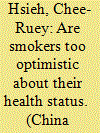| Srl | Item |
| 1 |
ID:
159039


|
|
|
|
|
| Summary/Abstract |
As the world has moved toward the era of non-communicable diseases, whether the individuals are in a capable position to accurately evaluate their own health status has an important implication on disease prevention in particularly and population health outcome in general. In this paper, we address four important questions surrounding the accuracy of health perception: (1) to what extent that individuals can make an accurate evaluation on their own health status; (2) what are the major factors influencing health misperception if any; (3) what are the causal directions between health behavior and health perception; and (4) whether individuals can learn and update their self-evaluation on health status over time and whether such learning is productive in that it mitigates the health misperception. Specifically, we use a longitudinal data set obtained from Taiwan that covers six waves of survey over about twenty-year period to compare the ex ante subjective perception on health and the ex post mortality hazards. Our results suggest that over one third of the survey respondents are not performing well in the evaluation of their own health status. We also find that smokers are more likely to have an optimistic bias on their own health assessment as compared to nonsmokers. After controlling for the simultaneous causality problem, we find a causal effect of individuals' misperceptions on continuing smoking, but not vice versa. In addition, our results show that individuals update their subjective perception on health over time through the learning from personal health shocks and the provision of public information on smoking hazards. Although the learning process tends to be overshooting among smokers, it is beneficial to mitigate the optimistic bias. We also find the evidence that personal health shock has a stronger impact on updating behavior than public information, indicating that personal experience is a more effective channel through which to correct the bias in health perception, compared to the provision of public information, such as anti-smoking campaign.
|
|
|
|
|
|
|
|
|
|
|
|
|
|
|
|
| 2 |
ID:
136266


|
|
|
|
|
| Summary/Abstract |
The geographic maldistribution of health care resources is one of the most persistent characteristics of health care systems around the world. Based on China’s provincial-level panel data in 1949-2010, this paper empirically investigates whether the geographic distribution of health care resources is convergent or divergent in the long run and whether the rapid economic growth contributes to reducing the regional disparity in health care resources in China. Using a dynamic convergence model that controls unobserved provincial heterogeneity and spatial dependence, the empirical results provide much support for β-convergence in that the provinces with lower initial values of health care resources, including the densities of physicians and hospital beds, are seen to grow faster and to catch up with the provinces with higher initial stocks. In addition, we find that GDP per capita has a significant and non-linear impact on the convergence rate of health care resources, providing support for a Kuznets curve in China’s health sector. That is, the inequality in the distribution of health care resources follows an inverted “U” shape as income increases over time. An important implication of our study is that economic growth per se provides a built-in stabilizer to mitigate health inequality through the convergence of health care resources across regions in the long run.
|
|
|
|
|
|
|
|
|
|
|
|
|
|
|
|
| 3 |
ID:
119211


|
|
|
|
|
| Publication |
2013.
|
| Summary/Abstract |
This paper estimates the labor supply functions for health care professionals in China using Census-based data in 2005. The rapid economic growth and population aging in China led to a substantial increase in the demand for health care services and the derived demand for health care professionals in recent years. However, the increase in the supply of doctors and nurses lags behind the growth in demand, raising the question of whether the excess demand should be met by expanding the health care manpower or by inducing the existing personnel to work more hours through wage increase. Our findings indicate that wage rate adjustment has a significant impact on the length of working time among the self-employed practitioners (with an estimated short-run elasticity of 0.575), while the labor supply of hospital employees is inelastic due to their fixed payment scheme. Instead, hours worked in the employee group are related to non-wage factors such as asset holdings and the hospital ownership type. An important policy implication of our study is that adjustments of labor compensation methods and hospital ownership structure are potentially effective approaches for coping with the excess demand for health care professionals and improving the quality of health care in China.
|
|
|
|
|
|
|
|
|
|
|
|
|
|
|
|